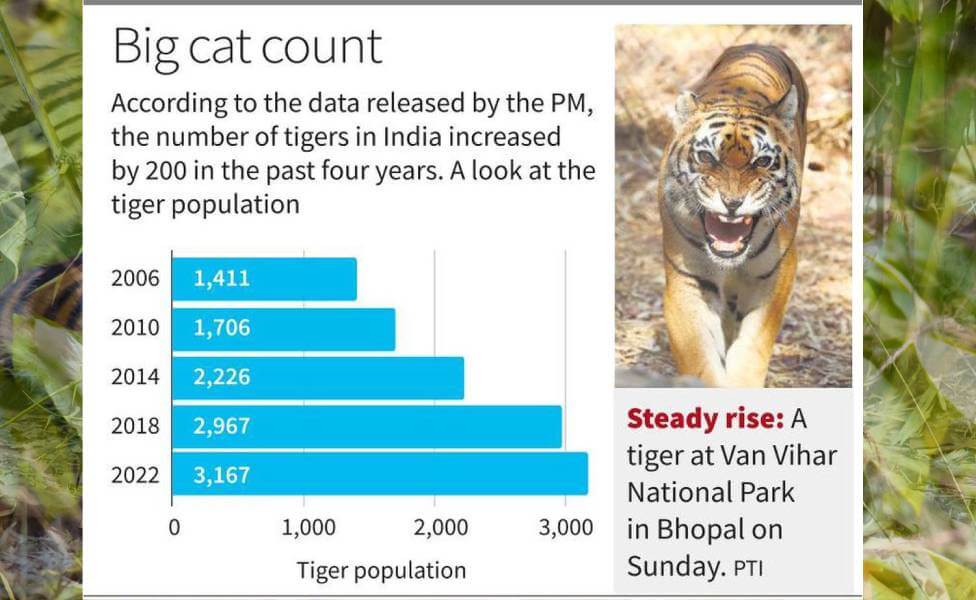“India’s 50 Years of Tiger Conservation Efforts Bear Fruit as Population Soars Beyond 3,000, As Per The Census Report Announced on Sunday, April 9, 2023”
India’s latest tiger census report, made public on Sunday, estimates that the country is home to at least 3,167 tigers. This figure seemingly indicates an increase compared to the previous census published in 2018. However, it’s important to note that this latest tiger census data does not specify the actual number of big cats residing in the country as a crucial calculation to determine the maximum and minimum range of the tiger population has not been carried out. The two figures, tiger census 2023 and 2018, aren’t strictly comparable.
According to an official involved in the census who spoke to the media, in 2018, the tiger population was recorded as 2,967, and in 2014, it was 2,226. It’s worth noting that Sunday’s numbers are provisional and could be subject to further revisions.
Yesterday, on April 9, the All India Tiger Census Report was announced by Prime Minister Narendra Modi in an event in Mysore on Sunday. The event marked the 50th anniversary of Project Tiger and the International Big Cat Alliance conference.
Also Read: Popular National Parks & Tiger Reserves in India
What is Project Tiger and how India became a leader in tiger conservation?

It is worth mentioning that Project Tiger is a conservation initiative launched in India in 1973 under National Tiger Conservation Authority (parent department) with the aim of protecting the country’s dwindling population of tigers, in short, tiger conservation in India. The project was initiated by the Government of India and the World Wildlife Fund (WWF) in response to the alarming decline in the tiger population in India due to habitat loss, poaching, and other factors.
The tiger project has been highly successful in achieving its objectives, and the tiger population in India has shown a significant increase since its inception. Starting from 1973 when Project Tiger was first established, India has come a long way in protecting and conserving its tiger population. Today, after 50 golden years of Tiger conservation in India, the country boasts of 53 project tiger reserves spread across a vast area of 75,796 square km, which accounts for approximately 2.3% of the country’s land area.
It’s worth noting that India is home to nearly 75% of the world’s tiger population, and tiger conservation efforts in India have been commendable. The tiger conservation success story of India in increasing the tiger population from 1,411 in 2006 to at least 3,167 at present is indeed remarkable.
What’s even more impressive is that India has achieved this feat without relying on fenced reserves, making it a global model worth emulating for other countries seeking to conserve their wildlife.
Also Read: Wildlife Conservation: Reasons Why We Need to Save Wildlife
Here’s a chart of the number of tigers in India from 2006 to 2023:

| Year |
Data |
| 2006 |
1,411 |
| 2010 |
1,706 |
| 2014 |
2,226 |
| 2018 |
2,967 |
| 2022 – 2023 |
3,167 |
Details of The Current Status of the Tiger in India

Tiger Population in India in 2023 has been calculated by adding the big cats caught in the cameras. Those who have not been captured, calculated by statistical techniques.
According to one of the scientists involved in the census exercise, Qamar Qureshi of the Wildlife Institute of India, 3,080 tigers have been caught in the camera traps. However, this is not complete data as the counting hasn’t finished yet. The actual number will include the State-wise break-up of tigers and the tigers outside the camera traps.
The scientists also explained that the census report shows an estimated data of tiger population and the mean value is highlighted as the final number.
For example, as per Tiger Census 2018 Report, the minimum and maximum value of the range were 2,603 and 3,346, respectively. So, the outcome came as a mean value of 2,967, which is also the tiger population in India 2019.
According to the tiger census 2023, India’s tiger population rises around 6% compared to the last data released in 2018. However, there has been a decline in the tiger population in the Western Ghats region. Despite this decline, there are reports suggesting that the major tiger populations in the Western Ghats remain stable.
The Shivalik hills and Gangetic floodplains have seen the highest growth in tiger population in recent years.
Central India and the northeastern hills have also witnessed a significant increase in the number of tigers.
The Brahmaputra flood plains and the Sundarbans have also shown a positive trend in tiger population growth.
These developments are encouraging and point towards the successful efforts of tiger conservation in India in preserving the tiger population in the country. While there is still much work to be done, it is heartening to see the progress made so far after 50 years of Project Tiger.
The current estimate on tiger populations also does not provide information on the number of tigers residing outside of protected areas. These tigers are increasingly vulnerable to environmental threats and human-animal conflicts.
The census report’s authors have warned that the growth of tiger populations is challenged in almost all of the five major tiger zones throughout the country. This is due to the escalating demands for infrastructure development.

In areas like the Shivalik hills and Gangetic plains, tigers are growing in number outside of Tiger Reserves in the landscape. Therefore, states like Uttarakhand and Uttar Pradesh must invest in reducing conflict with tigers and mega herbivores.
Wildlife habitats such as protected areas and corridors in the Central Indian highlands and Eastern Ghats are confronted with various threats. These include habitat encroachment, illegal poaching of tigers and their prey, excessive harvesting of non-timber forest produce, mining, conflicts between humans and wildlife, ever-expanding linear infrastructure, unregulated and illicit cattle grazing, human-initiated forest fires, and other reasons.
Given the presence of crucial mineral mines in the region, it is crucial to prioritise measures that mitigate mining impacts, such as utilising low-impact techniques and rehabilitating mining sites.
Also Read: Top National Parks, Tiger Reserves and Wildlife Sanctuaries in India
Increase in Tiger Population and Its Effects

As it is already discussed above, India is home to around 75% of the world’s tiger population. According to specialists, the majority of tigers in the country are concentrated in a few reserves that are nearing their maximum carrying capacity. Without the development of new areas as reserves, there may be obstacles to sustaining their population growth.
As it is already known that, India has recently relocated cheetahs from Africa and is now exploring international efforts to translocate big cats to other global locations, as per the reports. Discussions are underway with Cambodia, where the tiger population has been wiped out due to illegal poaching, to create an appropriate habitat and relocate a few species from the country to boost up tiger’s population in Cambodia.
The discussions with Cambodia to revive the tiger population in the region highlight the importance of collaboration and international partnerships in achieving conservation goals. With continued efforts and initiatives like these, we can hope to see a positive impact on the world’s endangered species and the preservation of their habitats.
Other Interesting Blogs to Read
Like & Follow our social media accounts at Twitter, Facebook, Linkedin & Instagram for getting the latest updates & offers on holiday packages.
Disclaimer: We do not take credit for some of the licenced paid images used in our blogs, whether from Google Images, Fotolia & Shutterstock. All such images are the copyrights of their respective owners and we try to provide credit for them wherever we can. If, however, any copyright image has been used on our blog, the concerned person can either mail us directly to remove the image or provide credit to whomsoever the image may belong to.
Frequently Asked Questions
How many tigers are in India by the latest 2023 tiger census report?
According to the latest 2023 tiger census report, there are 3,167 tigers in India.
Which State in India has the Highest Population of Tigers?
Madhya Pradesh has the highest population of tigers in India.
Which state in India has the lowest population of tigers?
Jammu and Kashmir has the lowest population of tigers in India.
About the author
From the ‘City of Joy,’ Kolkata, Nandini Bhattacharya is a Travel Writer by profession and traveller by passion. She loves to explore places around the world, new cultures, different cuisines and all new things that one can learn outside the home. She also loves to document her journey so that people can be inspired and travel more. Nandini is a nature lover and talks about sustainable tourism. She wants to make this world a good place where people can live healthy and happily.

 +91-9212777225
+91-9212777225 Plan Your trip
Plan Your trip




























